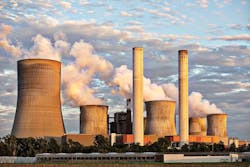WVU Researches Fracking & Power Plant Water Use
West Virginia University (WVU) researchers hope to reduce freshwater use at power plants by combining fracking wastewater and power plant wastewater.
West Virginia’s power industry is the biggest water user in the U.S., according to The Dominion Post. Fracking produces a type of wastewater called produced water and will produce from around 500,000 to 1 million gal per well, according to WHSV. The produced water from fracking can contain substances—magnesium, calcium and strontium, for example—that harm cooling towers in power plants.
However, when produced water from fracking is mixed with cooling tower blowdown water from power plants, those chemicals can precipitate out of the water. The outcome is clean water and two byproducts: chlorine and brine. According to WHSV, the chlorine will disinfect the cooling system and the 10-lb brine has industrial applications.
"The beauty of this approach is you solve two problems with one integrated solution," said Lance Lin, a civil and environmental engineering professor and principal investigator on the project, according to WHSV.
The team is in the early stages of the project, but has determined the ratio to get the best results and are looking to different treatments for the fracking and power plant wastewater, Lin said. The researchers obtained fracking wastewater from WVU’s Northeast Natural Energy research well for the project.
WVU Water Research Institute Director Paul Ziemkiewicz said the importance of mining to West Virginia increased the value of the research.
“It might not be a system that will be practical everywhere, but it is in West Virginia, which has a high concentration of coal and gas fired power plants sitting atop the nation's biggest natural gas play,” Ziemkiewicz said to WHSV. “If you’re going to start anywhere, this is the place to start.”
According to WHSV, the project is funded by a $400,000 grant from the West Virginia Department of Energy.
